A wood butcher block is a must-have tool in any pitmaster’s arsenal.
While typical cutting boards can be great for smaller cuts of meat, if you’re dealing with a whole brisket, multiple racks of ribs, or other large cuts, you need a durable, solid butcher block by your side.
I’ve tested five of the best butcher blocks at various price points for preparing, resting, and slicing meat.
The 5 Best Butcher Blocks Reviewed
1. Best Overall – [TAG14]
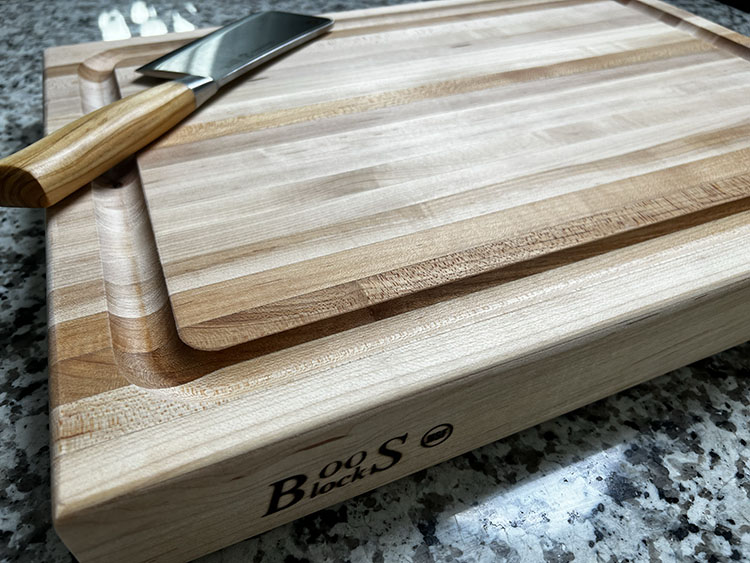
The John Boos Maple Wood Butcher Block is our favorite option if you’re looking for a heavy-duty butcher block.
This block weighs almost 20 lbs, so it’s not going to slide around on your counter while you’re trying to trim a rack of ribs, despite the lack of rubber feet. It is definitely not the type of block you want to transport with you, but it’s a great option if you are looking for a solid, durable block for your kitchen or workspace.
| Size: | 20” x 15” x 2.25” |
| Weight: | 19.5lbs |
| Type of Wood: | Maple |
| Grain: | Edge Grain |
| Juice Groove: | Yes |
| Rubber Feet: | No |
| Hand Grooves: | Yes |
It is made from Northern Hard Rock Maple Wood, which is recognized as one of the most durable butcher block materials in the world. It is also reversible and can be used on either side.
It features an edge grain design, so it will pick up knife marks and wear over time.
The juice groove is extremely generous and will catch any liquid from slicing up steaks or brisket, and keep it off your countertop.
The price point is a bit higher, but this is a high-quality butcher block that will last for a long time with proper care and maintenance.
The block also comes standard with a packet of mineral oil, which is a nice touch for the first few rounds of block maintenance.
What We Like:
- Deep Juice Grooves – These are well-positioned to prevent juice or other moisture from spilling over the sides. However, they are a little close to the center and limit your operational space somewhat.
- 1-Year Warranty – There’s a one-year warranty included with the purchase. It guarantees your product against any defects from the workmanship or wood used.
- High-Quality Maple – The wood used for the John Boos Block is high-quality and smooth to the touch. It looks fantastic and can improve the overall aesthetic of your kitchen both while in use and when it’s resting between meals.
What We Don’t Like:
- Heavy – This could be an issue when moving the board around and washing. The hand grooves for your fingers do help, though.
2. Best Custom Butcher Block – Grizzly Blocks
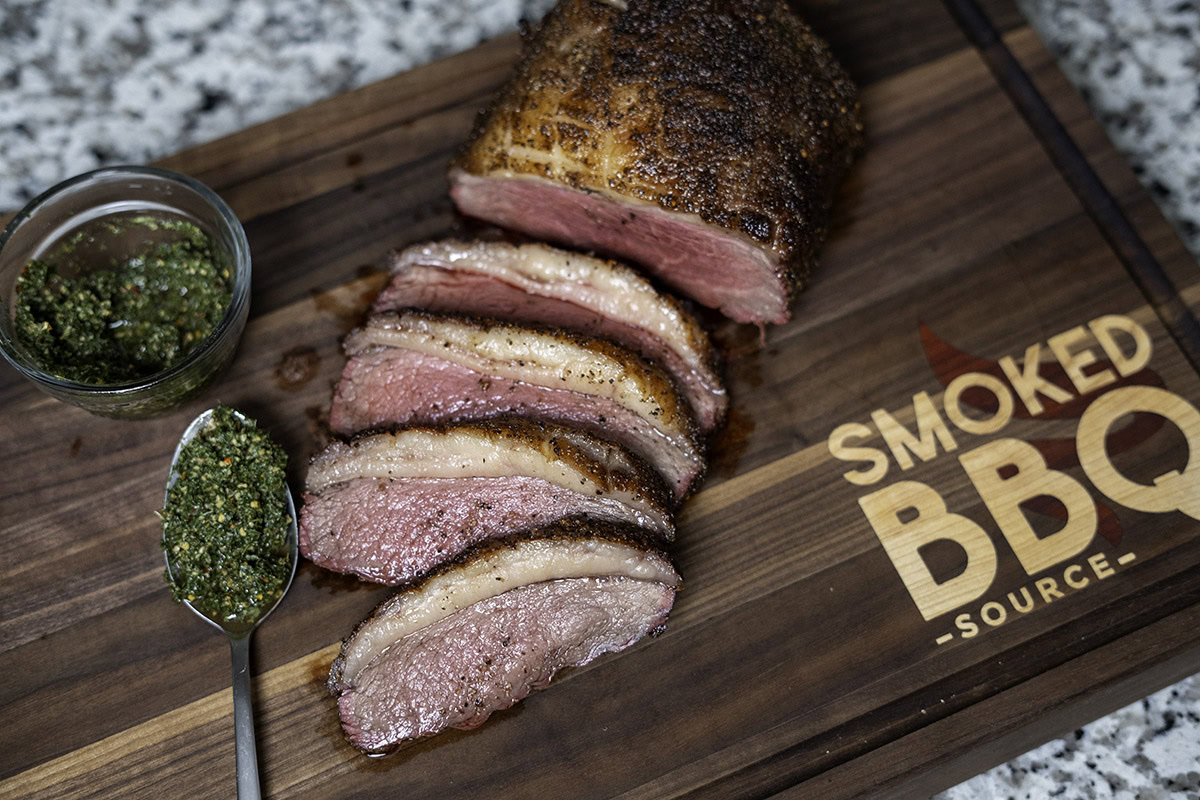
Grizzly Blocks custom-made this huge butcher block for us from maple hardwood
You can’t beat going custom to get exactly what you want in a butcher block. We went through this process ourselves recently to get some blocks made for our recipe photography. We ended up going with Grizzly Blocks who make all their boards by hand in Texas.
They allow you to customize everything from the size and shape of the board to the wood material, handles, epoxy inlays, and carvings. Wood options include walnut, cherry, maple, teak, ash, padauk, and purple heart, but they can also source custom exotic options if you have a preference.
They have a “Build Your Own Block” feature that lets you choose different settings and get an updated price. Once we made our order we had some back and forwarth to work out exactly what we wanted in terms of logo.
You can also choose from additions such as a juice groove, rubber feet, or hand grooves on any block design you choose.
To see a good selection of different designs possible, check out their Instagram page.
If you don’t want to wait, Grizzly Blocks also offers some ready-to-ship blocks.
What We Like:
- High level of customization – You can build a really unique block with the exact size, wood type, and additional features you need.
- Quality craftsmanship – Every board they sell is handcrafted in Texas so no part of the process is mass-produced.
What We Don’t Like:
- Pricy – You’re going to pay extra for something this high quality and custom, but if you look after your board, it will last you a lifetime.
3. Best Budget Butcher Block – [TAG26]
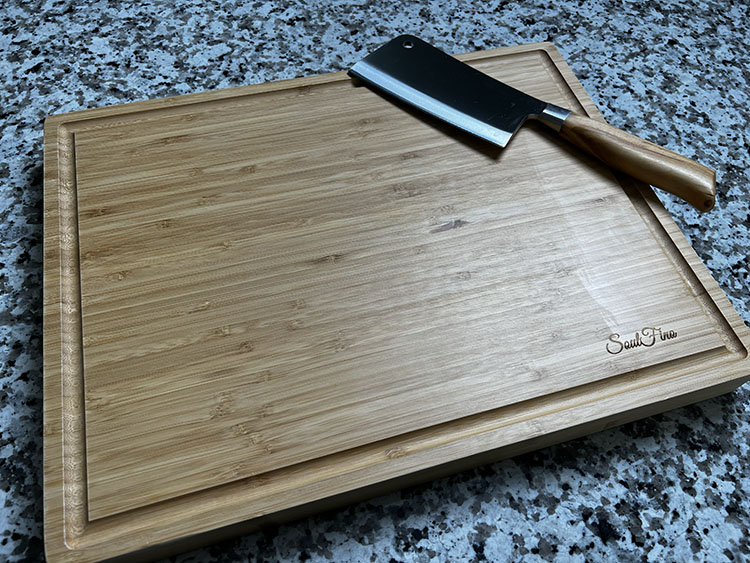
Our top choice for an affordable butcher block is the SoulFino Bamboo Cutting Board.
It is constructed from 100% Premium Organic Bamboo, making it lightweight yet strong.
While Bamboo blocks may not stand the test of time as well as other hardwood options, they are durable and reliable at a great price point.
| Size: | 17” x 13” x 1.5” |
| Weight: | 6.83lbs |
| Type of Wood: | Bamboo |
| Grain: | End Grain |
| Juice Groove: | Yes |
| Rubber Feet: | No |
| Hand Grooves: | Yes |
The SoulFino Bamboo block comes with a small juice groove and I did experience some spillage when slicing larger cuts of meat, but it is definitely adequate for everyday use.
I found that the board slid around my counter a bit while I was chopping, so I recommend placing a wet paper towel or grip sheet under the block prior to cutting.
Another great thing about a bamboo board is that the wood is inherently softer and, therefore, gentler on your knives than a sturdier hardwood. Bamboo is also a more low-maintenance option as far as wood choices go, so you won’t have to oil and maintain your board as frequently.
The bamboo material resists microbial contamination. It also doesn’t absorb liquid the same way that most wooden butcher blocks do.
The block is also equipped with handles on either side for easy carrying from the grill to the house.
What We Like:
- Lifetime Guarantee – The manufacturers of this butcher block offer a lifetime guarantee.
- Reversible Sides – This functionality still increases the life span of the block, as you won’t wear out one side faster than the other so long as you flip it every now and again.
- Doesn’t Dull Knives – The block has all the excellent aspects of bamboo butcher blocks, such as water resistance and durability. Its tendency to take on scars is also lower than with other bamboo blocks.
What We Don’t Like:
- Slides Around Sometimes – Be careful if you put a lot of weight into your cutting motions. You may accidentally help this block to slide around on your countertop.
While the bamboo isn’t as luxurious or long-lasting as some other blocks in this guide, this is a great value-for-money butcher block that is kind on your knives and large enough for resting and slicing a brisket.
4. Best Butcher Block for Multi-Use – [TAG32]
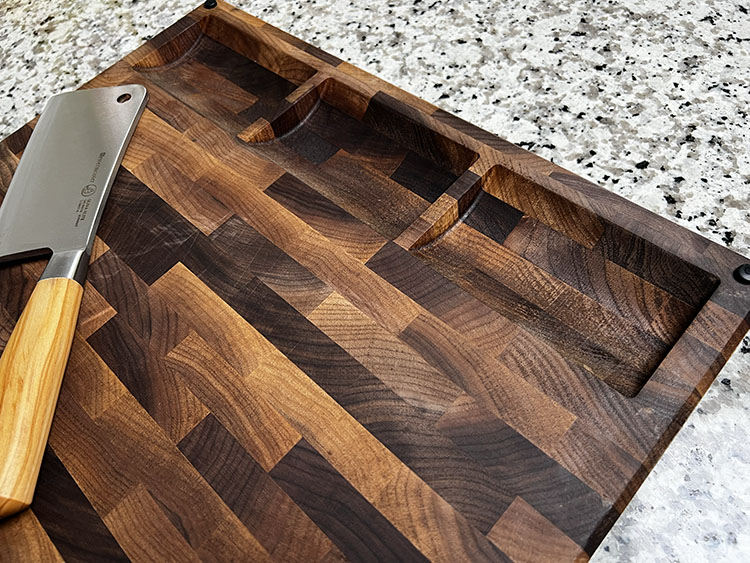
Our favorite butcher block for multi-use is the Sonder LA Alfred Cutting Board.
It is a smaller block but can be used for various applications. It is made from American Black Walnut and features an end-grain design that will protect your knives over time.
This board has three built-in compartments that can be used for prep or even as a charcuterie board when you are hosting a party. It’s a great option for smaller cuts of meat, as well as daily chopping, dicing, and carving.
| Size: | 17” x 13” x 1.5” |
| Weight: | 7.5lbs |
| Type of Wood: | American Black Walnut |
| Grain: | End Grain |
| Juice Groove: | Yes |
| Rubber Feet: | Yes |
| Hand Grooves: | Yes |
It is relatively lightweight and easy to transport from your kitchen to the smoker, plus the hand grooves on the side give you extra stability when transporting the board.
It has a juice groove around the edge with a 3.5oz capacity to keep your counters dry during the carving process.
Another great feature of the Sonder LA Alfred Box is that it comes in a beautiful gift box, making it a great option for gifts.
5. Best Lightweight Board: Ironwood Gourmet Charleston
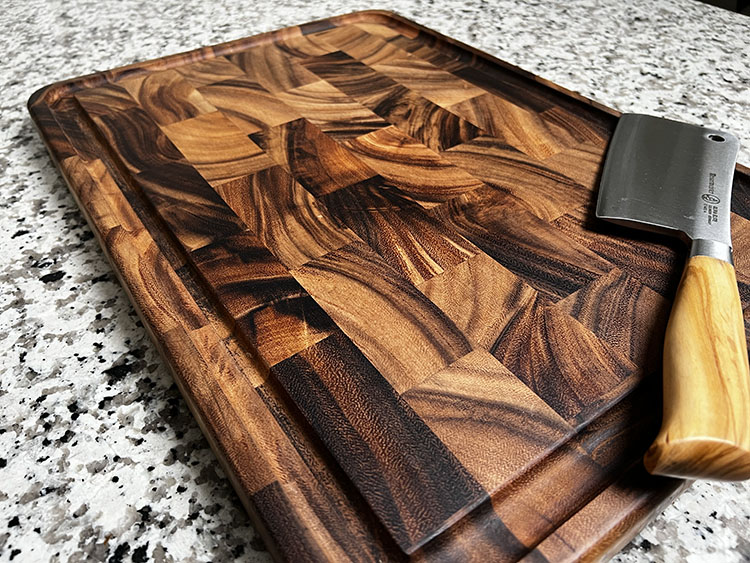
If you’re looking for a great quality chopping block that is lightweight and easy to move around, we recommend the Ironwood Charleston chopping block.
It is made from durable Acacia wood and boasts a beautiful, dark wooden color. It is lightweight and extremely portable.
| Size: | 14” x 20” x 1.5” |
| Weight: | 6.5lbs |
| Type of Wood: | Acacia Wood |
| Grain: | End Grain |
| Juice Groove: | Yes |
| Rubber Feet: | No |
| Hand Grooves: | No |
Another great feature of this particular block is the generous juice groove that will hold up to 6oz of liquid without spilling onto your counter, which is much larger than the other options on this list.
The lack of rubber feet does make sliding around on the counter a bit of an issue, but a wet paper towel beneath the board will solve that issue.
It does not have hand grooves on the side, so you may struggle with carrying the board, but because the block is so lightweight, it is still very easy to transport with or without meat.
Acacia wood is also very easy to maintain, and you will only need to oil the board regularly to keep it in good condition.
Why we recommend a wood butcher block for barbecue
Wood butcher blocks are superior to plastic cutting boards for a number of reasons.
- Most wooden butcher blocks have juice grooves cut into their edges to catch juice as you slice your meat.
- Wooden butcher blocks are usually large enough to fit a whole brisket. Finding plastic blocks large enough can be tricky.
- Wooden butcher blocks tend to wear better. Blocks made from maple or beech, for instance, don’t scar as easily as your average plastic block or block. This directly translates to a longer lifespan for your butcher block.
- They help keep your knives sharper over time. Many wood blocks cause a light sharpening effect for many cutting utensils depending on the wood type.
It’s better to purchase a high-quality wooden piece than a cheap plastic one. You’ll likely have to replace a cheap plastic block sooner rather than later.
The eco-conscious among you will appreciate that wooden butcher blocks come from a renewable resource.
Wood blocks are also typically made from waste wood that would otherwise be thrown away. This helps keep harmful plastic out of the environment and doesn’t require you to sacrifice quality.
What about when it comes to food safety?
Plastic cutting boards are considered to be more sanitary, and they are definitely easier to clean as they can be placed in the dishwasher.
However, studies show that many bacteria remain on a plastic block’s surface even after it has been thoroughly cleaned.
Cutting on plastic cutting boards also leaves lots of grooves where bacteria can hide. Wood is tougher to sanitize, but it’s also (often) tougher in general – you won’t find as many deep scratches in the surface.
Fast Facts About Cutting Boards and Food Safety in Your Kitchen
This is partially due to plastic’s tendency to be scarred by most knives. Bacteria can worm their way into these cracks and become hard to remove, eventually filtering into meat that you cut on the block’s surface.
Overall, wood is the way to go.
What to consider when buying
1. Size
Depending on the size of your kitchen or workspace, you want to find a butcher block that will fit well in your space. Butcher Blocks come in all shapes and sizes, but the most common sizes you will see in non-custom blocks are 18” x 12” and 24” x 18”.
Think about what you plan to use the block for. A whole packer brisket may struggle to fit on an 18” x 12” block, so if you plan to smoke a lot of briskets, then a 24” x 18” (or bigger) may be a better choice for you.
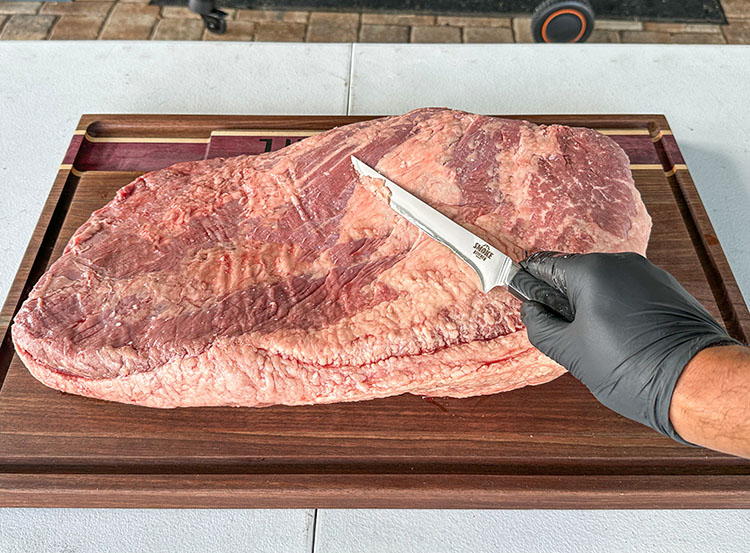
You need a large butcher block to hold a whole brisket for trimming and slicing
If you tend to handle smaller cuts of meat like whole chicken, pork butts, or tenderloins, then a smaller block should suffice.
Another thing to take into consideration when looking at the size of your block is the weight. If you plan to only use the block in your kitchen, then weight may not be as big of a factor. If you plan to travel with your butcher block (e.g., barbecue competitions), then you may not want to lug around a heavy block with you.
2. Type of wood
While virtually any wood butcher block will be better than a plastic cutting board, some types of wood are superior to others.
The best cutting boards are made from woods like maple, cherry, or walnut.
- Cherry is a good pick in many circumstances. Cherry end grain wood will last a long time and look wonderful in many kitchens, as well.
- Maple wood is another strong choice, and what we went with for our own custom boards. Maple is very strong and quite heavy, and end-grain wood possesses some of the best durability you can find. You’ll want to make sure you can easily lift your chosen block if you pick one with maple; the weight is no joke.
- You can also use walnut for your wooden butcher block. Walnut is dense and heavy and looks good, as well. It’s so dense that the odds of your knife slipping off its surface on an angled cut are practically nonexistent. You’ll get a satisfying sinking sensation with your knife a lot of the time.
- Bamboo makes for a good budget alternative. It’s even more environmentally friendly since it’s technically a species of grass rather than a tree. Bamboo butcher blocks absorb liquid less quickly than wooden blocks, and they can be just as sanitary.
Any of these will be excellent for a wooden butcher block. If you’ve already got a favorite among all three types, there’s nothing wrong with sticking with your preference.
3. Edge Grain vs End Grain
Edge-grain butcher blocks are laminated hardwood strips. The hardwood is turned on its edge (hence the name), and the length of the grain is fully visible.
Edge grain blocks are great for butchering, chopping, and prep, but they will be quicker to show signs of wear and knife marks over time. They can also be rougher on your knives, so you may need to anticipate a bit more knife sharpening with this option.
End Grain butcher blocks are hardwood pieces that are laminated together in a vertical fashion. This option is far more gentle on knives and will show less wear and tear over time as the natural wood grain will catch and release your knife during chopping.
End-grain butcher blocks require more oiling over time and need to be conditioned more frequently. They are a better choice if you are looking for a thicker butcher block.
We have a guide that compares more of the differences between end grain vs edge grain.
4. Price
Let’s be honest, price is an important factor when you are deciding what type of butcher block to purchase. Prices can range from as low as $50 to upwards of $500+ for quality, custom blocks. Before you start shopping, it’s important to determine exactly what you plan to spend and what type of investment you want to make.
You can find great quality butcher blocks in the $50-$100 range, but you may forego some quality and features that you will find in higher-priced blocks on the market. It’s also important to remember that a butcher block should be considered an investment because the higher quality block you choose, the longer it will last before you need to make another investment.
5. Design Features
There are a number of design features that you can find when shopping for butcher blocks that may or may not be important to you. Here are some of the most popular design features you will find and what they are for:
Juice Groove – a juice groove is a groove that runs around the outside edge of your block.
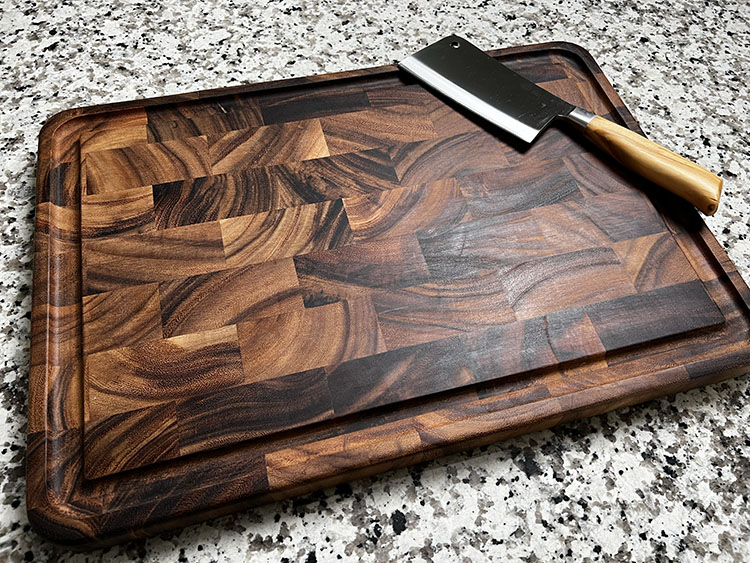
This feature is intended to catch the juice and drippings that escape the meat during carving. Without a juice groove, you will end up with more meat drippings on your workspace and a bit more clean-up to deal with.
Rubber Feet—Rubber feet are found on several popular butcher blocks. They are located on the bottom side of the board to prevent the block from moving while you are cutting.

While you can also place a wet paper towel under your block to achieve the same result, it’s nice to be able to skip that step on a block that has rubber feet integrated into the design.
Hand Grooves—Hand grooves are little handholds on the sides of your butcher block. They make the board easier to pick up and carry from place to place.
How to oil and clean your wood butcher block
Purchasing your wood butcher block is only half the battle. You’ve also got to maintain the block so it’ll continue to be usable for years to come.
Good maintenance also leads to a block that looks good for years to come.
Although wood is the most sanitary butcher block material, it can also absorb juices and bacteria since wood is naturally porous.
This video contains a lot of tips for cleaning and maintaining your butchers block.
A lot of moisture built up inside a wooden block can warp the wood material or cause it to expand and crack; this is a fast track to a busted butcher block.
Rotting wood smells terrible and is unsanitary for food preparation, so in many cases rotting blocks have to be thrown away wholesale.
To avoid this fate, you should always oil your butcher block after you purchase it:
- Take a normal food-safe mineral oil. You can find some variants at your local grocery store or at home furniture stores.
- You’ll want to soak the block in oil, spreading plenty of it across the surface to the point that it seems to be too much.
- After you’ve saturated the block, rub the oil off the surface with a regular dish towel.
An important note: this dish towel should be used for the maintenance of your butcher block from this point onward. Don’t use it for other tasks.
If you’ve done this correctly, your block should look slick and full of oil.
Give the block a few minutes to air dry, then return and you’ll find that the oil should be mostly absorbed by the wood’s pores.
For optimal results, the block’s surface should be relatively uniform in color. If there are dry or “thirsty” spots, you can add more oil and repeat the process.
Do this for one side of the block at a time. Both sides need to be given time to air dry. The best way to manage this is to let your cutting block sit upright in a lid or dish holder so that both sides get exposure overnight.
This oiling should be repeated every time you see the block’s oil layer starting to get thin. You’ll be able to tell that it’s thin if water can drip onto the surface and doesn’t bead away. Water that penetrates the wood isn’t being blocked by the oil.
Did you miss our previous article...
https://manstuffnews.com/backyard-grilling/twice-baked-potato-casserole
 Backyard GrillingWeekend WarriorsAdvice from DadBeard GroomingTV Shows for Guys4x4 Off-Road CarsMens FashionSports NewsAncient Archeology World NewsPrivacy PolicyTerms And Conditions
Backyard GrillingWeekend WarriorsAdvice from DadBeard GroomingTV Shows for Guys4x4 Off-Road CarsMens FashionSports NewsAncient Archeology World NewsPrivacy PolicyTerms And Conditions
